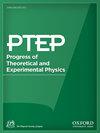PIKACHU 项目的首次研究:开发和评估用于 160Gd 双β衰变搜索的高纯度 Gd3Ga3Al2O12:Ce 晶体
IF 8.3
4区 物理与天体物理
Q1 Physics and Astronomy
引用次数: 0
摘要
揭示无中微子双β衰变(0ν2β)对于证实中微子的马约拉纳特性至关重要。从理论上讲,0νβ 的衰变率是不确定的,受到核基质元素的影响,不同核素的衰变率各不相同。为了减少这种不确定性,必须精确测量不同核素的中微子发射双β衰变半衰期(2ν2β)。我们启动了 PIKACHU(为挑战地下科学而在近冈进行的纯无机闪烁体实验)项目,以制造高纯度掺杂 Ce 的 Gd3Ga3Al2O12(GAGG)单晶体,并利用它们来研究 160Gd 的双β衰变。两个核矩阵元素计算理论模型对 160Gd 中 2ν2β 的预测显示,估计的半衰期存在显著差异,相差约一个数量级。如果较低的半衰期估计值成立,那么探测 160Gd 中的 2ν2β,其灵敏度会比使用掺杂 Ce 的 Gd2SiO5(GSO)晶体的先前研究提高一个数量级以上。通过对原材料的精炼和筛选,我们成功研制出了纯度超过以往标准的 GAGG 晶体。我们用这些晶体进行的实验表明,达到超过早期研究的灵敏度是可行的。本文讨论了正在进行的高纯度 GAGG 晶体开发和闪烁体性能评估,以及 PIKACHU 实验的预期未来前景。本文章由计算机程序翻译,如有差异,请以英文原文为准。
First Study of the PIKACHU Project: Development and Evaluation of High-Purity Gd3Ga3Al2O12:Ce Crystals for 160Gd Double Beta Decay Search
Uncovering neutrinoless double beta decay (0ν2β) is crucial for confirming neutrinos’ Majorana characteristics. The decay rate of 0νββ is theoretically uncertain, influenced by nuclear matrix elements that vary across nuclides. To reduce this uncertainty, precise measurement of the half-life of neutrino-emitting double beta decay (2ν2β) in different nuclides is essential. We have launched the PIKACHU (Pure Inorganic scintillator experiment in KAmioka for CHallenging Underground sciences) project to fabricate high-purity Ce-doped Gd3Ga3Al2O12 (GAGG) single crystals and use them to study the double beta decay of 160Gd. Predictions from two theoretical models on nuclear matrix element calculations for 2ν2β in 160Gd show a significant discrepancy in estimated half-lives, differing by approximately an order of magnitude. If the lower half-life estimation holds true, detecting 2ν2β in 160Gd could be achievable with a sensitivity enhancement slightly more than an order of magnitude compared to prior investigations using Ce-doped Gd2SiO5 (GSO) crystal. We have successfully developed GAGG crystals with purity levels surpassing previous standards through refined purification and selection of raw materials. Our experiments with these crystals indicate the feasibility of reaching sensitivities exceeding those of earlier studies. This paper discusses the ongoing development and scintillator performance evaluation of High-purity GAGG crystals, along with the anticipated future prospects of the PIKACHU experiment.
求助全文
通过发布文献求助,成功后即可免费获取论文全文。
去求助
来源期刊

Progress of Theoretical and Experimental Physics
PHYSICS, MULTIDISCIPLINARY-PHYSICS, PARTICLES & FIELDS
CiteScore
12.00
自引率
5.70%
发文量
148
审稿时长
17 weeks
期刊介绍:
Progress of Theoretical and Experimental Physics (PTEP) is an international journal that publishes articles on theoretical and experimental physics. PTEP is a fully open access, online-only journal published by the Physical Society of Japan.
PTEP is the successor to Progress of Theoretical Physics (PTP), which terminated in December 2012 and merged into PTEP in January 2013.
PTP was founded in 1946 by Hideki Yukawa, the first Japanese Nobel Laureate. PTEP, the successor journal to PTP, has a broader scope than that of PTP covering both theoretical and experimental physics.
PTEP mainly covers areas including particles and fields, nuclear physics, astrophysics and cosmology, beam physics and instrumentation, and general and mathematical physics.
 求助内容:
求助内容: 应助结果提醒方式:
应助结果提醒方式:


